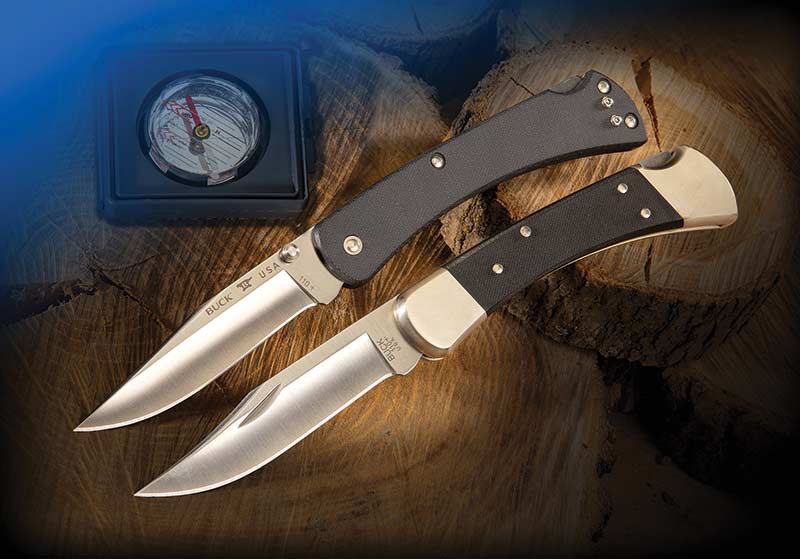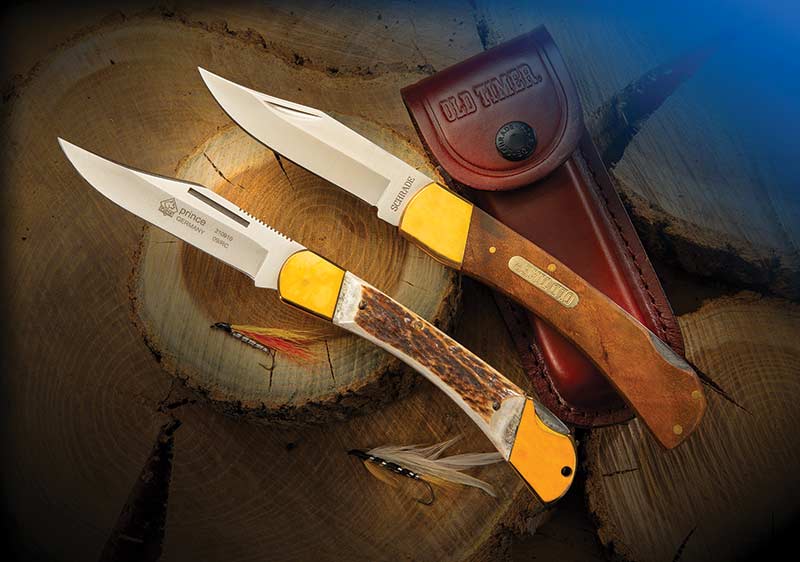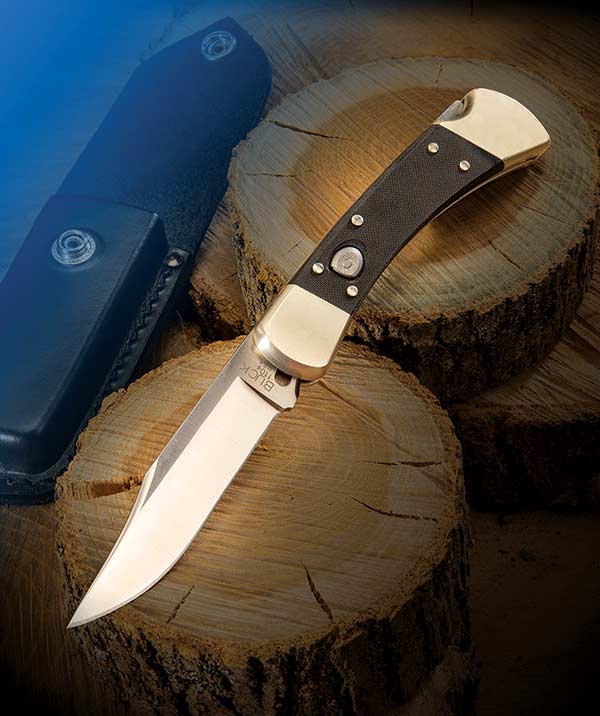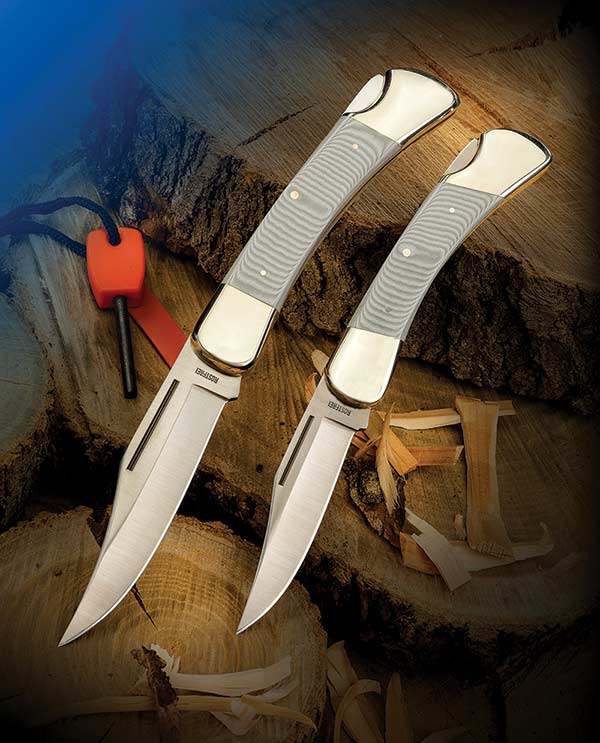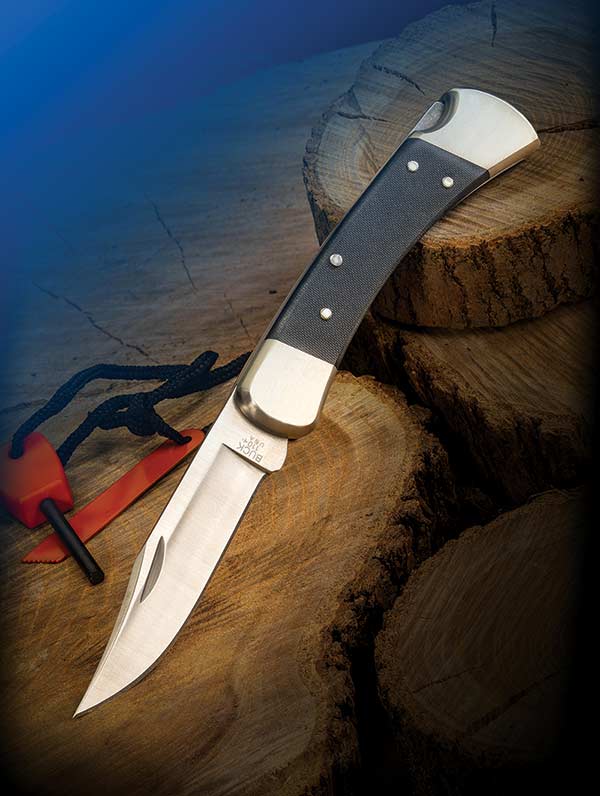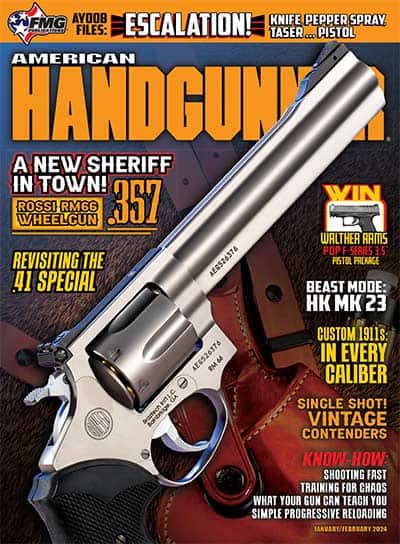60 Years Strong!
Six Decades Later, The Buck 110 Still Rules The Roost.
The venerable Buck 110 celebrates its 60th anniversary of non-stop production, a run that continues to defy the odds in a competitive world where the major cutlery companies are waging cutthroat competition on a high-tech battlefield. While designers and engineers spar in this modern War of the Edges, the Buck 110 sits on the riverbank watching the river flow. Buck is casually producing a million units a year while other manufacturers are producing 110 look-alikes in their current lines. It is the most successful outdoor folding knife of all time — and most copied.
In 1964, Buck Knives, in its second year of incorporation, unleashed their new 110 Folding Hunter, an innovative outdoors knife whose parameters were to have a blade that could serve for skinning game and general utility and equip it with a lock to bolster reliability. The “lock-back” blade mechanism had been around in various forms since the early 1850s, gaining attention on folding knives produced in the legendary cutlery centers of Sheffield, England and Solingen, Germany. Streamlined by Buck, it proved to be a huge factor in the Buck 110’s success because, up until that time, folding knives were not trusted for heavy-duty field chores.
Once hunters tried it and found it to their liking, the Buck 110 was off to the races, and here it is, 60 years later, still racing. Buck made smaller versions of the 110 Folding Hunter, such as the 112 Ranger, which was promptly copied by other manufacturers and still is today. Over the years, Buck has produced variations of the 110 as well, including a push-button automatic and a plethora of lightweight versions. There are also upscale Stag-handled send-ups as well. The world is Buck Knives’ oyster.
Imitation being the most sincere form of flattery, we decided to honor the Buck 110 by showing you the impact it’s made on the rest of the cutlery world. It is the most imitated, knocked-off folding knife in the history of mankind, both domestically and abroad, still showing up in manufacturer’s catalogs year after year. Join us in celebrating 60 years of Buck 110 bliss. The Buck Collectors Club has a great resource for the Buck 110 found at HistoryOfThe110.com.
Domestic Dominance
The Buck 110 quickly became a sales juggernaut in the U.S., and a host of domestic manufacturers wanted a piece of the action. Schrade has had great success with Buck’s Folding Hunter platform in both their Old Timer and Uncle Henry knife lines. The Cave Bear is Old Timer’s 110 equivalent, and it, along with smaller variants, has been a staple for the manufacturer for decades. They offer a second version of the folder dubbed the Golden Bear that differs in that it has no bottom bolster.
Most of the Old Timer renditions are sold with synthetic Sawcut Delrin handle scales and high-carbon steel blades. The Uncle Henry send-up of the 110 is the Bear Paw. This knife comes in both Wood and Faux Stag scales and, better yet, a real Fat Stag version is available. Most of Old Timer’s offerings are stainless steel. A historical note here: If you see a tang stamp with “SCHRADE+” — it’s stainless.
Here’s what you need to know if you want to collect or purchase these knives. In 2004, Schrade shuttered its factory in Ellenville, NY, due to bankruptcy. They were purchased by multi-brand conglomerate Taylor Brands LLC, that moved all Schrade production to China, so if you want a U.S.A.-made Schrade, you must purchase a knife before that date. In 2016, Smith and Wesson Holding Corporation’s Battenfeld Technologies division purchased Taylor Brands LLC, which continues to run the operation today. As I write this, there are a host of U.S. companies with 110-alikes in the current lines, including KA-BAR, Bear & Son, Winchester, Rough Ryder and Frost.
Europe Takes Note
No other European manufacturer has done 110 Buck-alikes to the extent Puma Knives has. They are to Europe what Schrade is to the U.S. market. Puma jumped on the Buck Folding Hunter design as early as a year after its release with a model called The Plainsman, but by 1970, had changed it to The Game Warden, which it remains today. Like Buck, they make smaller versions, which are also in their current line. There are also other names like the Sergeant and General with nickel silver bolsters and synthetic scales and some with solely synthetic “Featherweight” handles — all of which are good indicators of how invested they are in the 110 design.
Puma sells their knives in different price structures under two major umbrella lines — the standard all-German-made models, which command a higher price, and the SGB brand, which feature their German factory blades, but the knives themselves are assembled offshore in the Orient to sell for a more pedestrian price. Their reasoning for the SGB line is — as their catalog states, “When it matters, wouldn’t you prefer a German blade over a Chinese blade?” Point taken. One thing you can say about Puma knives is they have high quality standards, and their prices are in line with Bucks.
Herbertz Knives is a German manufacturer/distributor that has been around for generations. Currently, they have a 110-alike in their catalog dubbed the Dark Wood Back Lock. It is a handsome version of the Buck original, but is far from their first. The two stunning light gray/medium gray handled versions pictured here were produced in the 1980s and not in Germany but in Seki City, Japan. According to the seller, these knives were “made by Seizo Imai in Seki, Japan. Herbertz is a German company, and Imai made quite a few different knives for this company, as did other Seki knifemakers in the past.” The “Rostfrei” tang stamp is generic and simply means the blades are made of stainless steel in the German language. My source acquired his stock of these collectibles from the original purveyors in Seki City, the knifemaking capital of Japan. These knives are impeccably crafted, and it’s easy to see why Spyderco had some of their upscale knives in “Seki” long before the Asian (mainly China) invasion took over a huge chunk of global cutlery production.
Buck: Still The King
We’ve covered a mere fraction of the piggybackers that have feasted at the Buck 110 Folding Hunter dinner table, but it is interesting to note no other manufacturer — zip, zero — has ever posed a threat to the Buck original. We don’t expect that to change. What we can expect is we’ll be right back here 10 years from now, writing a 70th anniversary update.
For more info: BuckKnives.com

